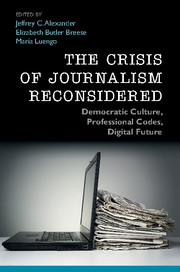Book contents
- Frontmatter
- Dedication
- Contents
- About the Contributors
- Preface
- Acknowledgments
- Introduction: Journalism, democratic culture, and creative reconstruction
- PART I THE CRISIS NARRATIVE
- PART II FEARS OF DIGITAL NEWS MEDIA: THE SYMBOLIC STRUGGLE
- PART III PROFESSIONAL JOURNALISM, CIVIL CODES, AND DIGITAL CULTURE
- Conclusion: News innovations and enduring commitments
- Index
- References
Conclusion: News innovations and enduring commitments
Published online by Cambridge University Press: 05 June 2016
- Frontmatter
- Dedication
- Contents
- About the Contributors
- Preface
- Acknowledgments
- Introduction: Journalism, democratic culture, and creative reconstruction
- PART I THE CRISIS NARRATIVE
- PART II FEARS OF DIGITAL NEWS MEDIA: THE SYMBOLIC STRUGGLE
- PART III PROFESSIONAL JOURNALISM, CIVIL CODES, AND DIGITAL CULTURE
- Conclusion: News innovations and enduring commitments
- Index
- References
Summary
This much is far from being news: New technologies and practices support and structure daily news work. The studies in this volume – of the Philadelphia news scene (Anderson), state house press corps in New York and Bavaria (Revers), local online news in the American West (Ryfe), citizen-journalist bloggers in post-Katrina New Orleans (Ostertag), newsrooms of large and medium city newspapers in the USA (Usher), a documentary film about The New York Times (Carlson), and others – illustrate how new digital tools and technologies structure the work of journalists in diverse media contexts. We see how online news blogs, video blogs, Twitter, data aggregation, online-only news sites, website traffic measurement, and other new technological forms organize newsroom operations and inform the decisions of editors and publishers, as well as the character of entire media organizations. Many of these technologies and practices – now daily, unavoidable, and influential – were unknown just a decade ago.
To many communications and social science scholars assessing the impact of such pervasive change on the news, these new technologies and practices of journalistic production and dissemination represent tangible sites and sources of “crisis” for journalism. Digital news brings about economic change, which in some cases obliterate journalists’ job prospects and professional security. Journalism speeds up, and journalists struggle to keep pace. Continually published updates on Twitter and online news streams force journalists onto a “hamster wheel” of news production, demanding frequent updates and preventing deep investigation and consideration of the topic at hand (Usher). While print journalism required advertising dollars to sustain it, online journalism demands clicks to attract revenue, which shifts the orientation of journalism to “clickable,” consumable media. Scholars and commentators point out that journalism measured by web traffic privileges the production of aggregated news over original, well-researched articles.
The studies in this volume challenge us to see that enduring standards of journalism support and frame the narrative of crisis, which, in turn, reinforces those standards of professional journalism. Instead of seeing new technologies and practices as representative of crisis, the authors in this volume enable us to see how they are situated in and described by narratives and symbolic codes. In this light, journalism's identity derives from cultural codes of the civil sphere (Alexander 2006).
- Type
- Chapter
- Information
- The Crisis of Journalism ReconsideredDemocratic Culture, Professional Codes, Digital Future, pp. 282 - 290Publisher: Cambridge University PressPrint publication year: 2016
References
- 7
- Cited by

